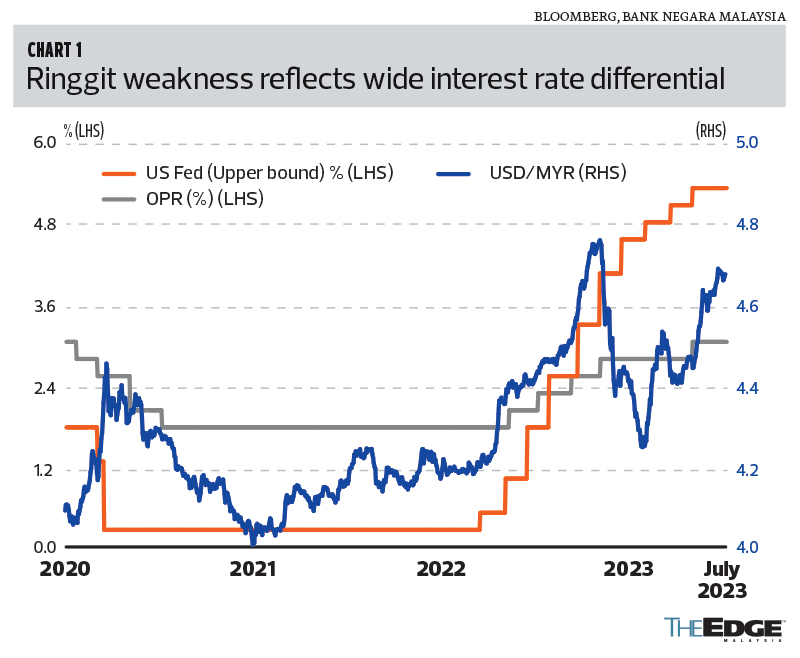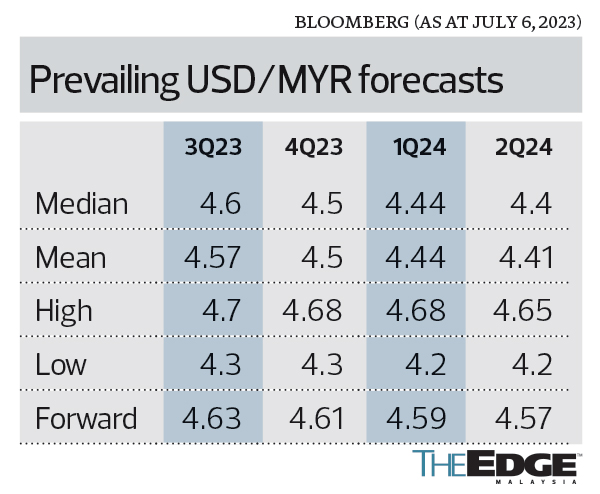
This article first appeared in The Edge Malaysia Weekly on July 10, 2023 - July 16, 2023
AS the Ministry of Investment, Trade and Industry (Miti) held an open day on July 6 to gather feedback and win some early buy-in for the soon-to-be-launched New Industrial Master Plan (NIMP) 2030, Bank Negara Malaysia’s monetary policy committee (MPC) had its final deliberations for what we now know as a not-so-hawkish pause for its overnight policy rate (OPR) at 3%.
Although admitting that the OPR remains “slightly accommodative”, the MPC “continues to see limited risks of future financial imbalances” and expects both headline and core inflation to trend lower in the second half of this year — subject, of course, to any changes in domestic policy on subsidies and commodity prices. In other words, at most, there will be only one more hike of 25 basis points (bps) this year, if any, say economists and rate watchers (see Page 12).
The MPC’s statement made no mention of the ringgit, whose value recently skidded to its lowest year to date (YTD) against several key currencies — unlike the June 27 statement by the financial market committee (FMC), where the FMC chairman and Bank Negara assistant governor Adnan Zaylani said the central bank “will intervene in the foreign exchange market to stem currency movements that are deemed excessive”.
Ahead of the FMC meeting, the ringgit closed 5.8% weaker YTD at 3.4718 against the Singapore dollar and 9.1% weaker YTD at 5.1217 versus the euro on June 22, as well as 6.2% weaker YTD at 4.6783 against the US dollar on June 23.
The ringgit has since held up against those currencies but continues to slide against the pound sterling. With the Bank of England (BoE) seen possibly to have bigger hikes left this year than the US Federal Reserve at this point, the ringgit skidded to 5.9329 against the pound on July 6, the same day as the MPC pause. That makes school fees and holidays to the UK 12% dearer than when the ringgit ended against the pound at 5.2993 in 2022, when the BoE’s key rate was 3.5% compared with 5% today and possibly closer to 6% by year end.
To recap, the Fed — which is expected to raise interest rates two more times this year to bring its terminal rate closer to 6% by year end from a range of between 5% and 5.25% since May and possibly keeping them high until early 2024 — had raised its key policy rate by 500bps between March 2022 and May 2023 (see Chart 1).
Including their rate hikes in June (when the Fed paused), the European Central Bank had increased interest rates by 400bps to 4% while the BoE had raised its monetary policy rate by 450bps to 5% since the Fed-led rate normalisation in March last year.
Bank Negara, meanwhile, has raised the OPR by 125bps to 3%, less aggressive than Bank Indonesia’s 225bps to 5.75%, Bangko Sentral ng Pilipinas or the Philippine Central Bank’s 425bps to 6.25% and even the Bank of Thailand’s 150bps to 2%. The State Bank of Vietnam (SBV), which trimmed rates four times this year to spur growth, has its key rate at 4.5% currently.
Frederic Neumann, chief Asia economist and co-head of HSBC Global Research Asia, who expects “one more hike of 25bps before the Fed goes on hold for an extended period”, reckons that “rate cuts may only come into play by the second quarter of 2024”.
Ringgit may hit 4.88?
Sailesh Kumar Jha, chief economist and head of financial market research at RHB Banking Group in Kuala Lumpur, is among experts who are bearish about the ringgit’s performance in the near term, though he reckons that Bank Negara may have one more hike of 25bps left this year to lift the OPR to 3.25%.
“The ringgit might underperform other currencies in Southeast Asia as the catalysts for capital flows to these other markets could be more formidable compared to Malaysia, where the government is at the early stages of announcing structural reforms to create a more conducive investment climate,” he writes in a July 7 note, telling clients that the ringgit “is likely to be under pressure in 2H2023 as its negative carry against the US dollar is likely to rise, given the widening interest rate differentials between the OPR and federal funds rate [which] are likely to accelerate to a peak of 5.5% to 5.75% by 2H2023”.
The additional increase may come to improve sentiment on the ringgit, on the back of sticky core inflation, despite Bank Negara not likely to go for an interest rate defence of the ringgit.
Going on “an interest rate defence of the ringgit could require a peak OPR of around 3.75% [which is above] the historical peak of 3.5%”, Sailesh had written in a May 19 note, telling clients that the ringgit — being “a negative carry currency” (where returns are less than the cost of holding it) — “could retest the historical peak of 4.748 [versus the US dollar] by 3Q2023”, given negative sentiments and limited fiscal reforms.
Now, Sailesh thinks “the balance of risks are tilted towards a print of about 4.88” for USD/MYR in 4Q2023, though RHB’s forecast is for the ringgit to end 2023 between 4.70 and 4.80 against the US dollar.
When asked why economists at RHB do not subscribe to the view that the weakness in the ringgit is mainly due to external factors and not domestic in nature, Sailesh tells The Edge that “domestic confidence in ringgit is deteriorating with stock market volumes having collapsed and FX (foreign exchange) deposits remaining at high levels”.
“In addition, some of Malaysia’s external vulnerability ratios are signalling red. As FX reserves are likely to drop to US$109 billion within three months, these external vulnerability ratios will gather even more steam and cause even more upward pressure on USD/MYR,” he says.
On top of known factors like a high debt-to-GDP ratio and limited fiscal space, RHB’s Sailesh is also closely watching several monetary ratios for potential pain points. These include the rise in foreign currency deposits against the M1 money supply (the most liquid form of money, including cash), rising M2 (which includes money in savings accounts) against foreign reserves, the rise in short-term debt against foreign reserves as well as trends in direct and portfolio investments versus the gross domestic product (GDP).
Outflows thinning surplus
Joey Chew, head of Asia FX Research at HSBC Global Research Asia in Hong Kong — who in March told The Edge how savings in foreign currency had risen significantly in Malaysia and was among those who still thought the ringgit could regain ground to even touch 4.20 by year end — has since revised her year-end forecast for USD/MYR to 4.40, noting how “the Fed’s rate hike cycle has been prolonged with the pause-skip and two more rate hikes implied in the dot plot”, as well as the fact that “China’s growth had stumbled and the renminbi (RMB) has weakened”.
HSBC’s USD/MYR forecast is still more optimistic than median forecasts of 4.50, according to Bloomberg data at the time of writing (see table). Having said that, HSBC’s Chew notes how “local portfolio investments overseas have picked up” even as Malaysia’s “trade surplus has narrowed due to lower commodity prices and weakening global demand”.
Both factors mentioned can weigh on a country’s balance of payments, even though Malaysians’ increasing portfolio investments overseas in itself is not necessarily a bad thing. According to Bank Negara data, the country’s financial account saw a net outflow of RM2.36 billion in 1Q2023, largely due to a net portfolio outflow of RM33.3 billion, which is sizeable relative to the net investment portfolio outflow of RM50.56 billion for the whole of 2022 and the current account balance of RM4.28 billion in 1Q2023.
Asked about the FMC statement, Chew replies that “it is not surprising that Bank Negara may have already been trying to defend the ringgit”, judging from the level of the central bank’s foreign reserves as well as outstanding FX forwards in the second quarter.
“Foreign exchange intervention by central banks is not uncommon as a means to curb excessive volatility, but it doesn’t change the underlying issues such as negative yield differential, economic linkages of the country and financial correlation with a weak RMB deterioration in terms of trade,” she elaborates.
Indeed, Bank Negara’s foreign reserves had declined by a total of US$4.1 billion over three straight months to US$111.4 billion at end-June from US$115.5 billion at end-March. In April and May alone, the central bank’s headline reserves declined US$2.8 billion, slightly more than the US$2.6 billion reduction in its forward liabilities during the period to US$23.7 billion, which is still 21% of reserves at end-May (see Chart 2). Though headline reserves are still enough to cover one time short-term external debt, the ratio had slipped from 1.2 to 1.3 times in late 2021 and early 2022, central bank data shows.
Despite her more sanguine forecast for USD/MYR, Chew reckons that few things need to happen before investors are more confident of holding the ringgit again. These include the end of the Fed rate hike cycle, broad weakening of the US dollar, a stronger RMB, as well as an improvement in global trade. “Domestically, [there needs to be] less political uncertainty, more economic reforms/policies,” she adds.
That would cast the spotlight on the revival of domestic and foreign investment by NIMP 2030, which is slated for launch after the six state elections on Aug 12 and ahead of the mid-term review of the 12th Malaysia Plan in September as well as the tabling of Budget 2024 on Oct 13.
“There is a wait-and-see stance among many investors, waiting for hints at what Budget 2024 might bring. The upcoming [state] elections may help shape expectations around future policy plans at the national level. The further targeting of subsidies, for example, might feature in future budget plans, as might expenditure priorities on infrastructure and education. Over time, budget consolidation would help Malaysia build resilience against potential, long-term economic shocks,” says HSBC’s Neumann, who reckons that “softening investor confidence is likely more a reflection of broader, global financial market uncertainty than an idiosyncratic judgement on Malaysia’s medium-term growth prospects”.
Even so, it is clear that Malaysia must not disappoint for the ringgit to see better days.
Save by subscribing to us for your print and/or digital copy.
P/S: The Edge is also available on Apple's App Store and Android's Google Play.
- Tariff shock awaits China after trade surplus hits US$103 bil
- Maybank customers can now make QR payments through MAE app in Cambodia
- Malaysian semiconductor stocks fall amid US probes, software firms steady
- HRD Corp's chief executive Shahul Hameed steps down, confirming The Edge report
- Malaysia to bear brunt of weaker exports to US, Macquarie flags
- China’s sees another ‘50 golden years’ with Malaysia, says Xi
- Government considering motorcycle lanes on future highways — Nanta
- Skygate Solutions buys 51% stake in engineering firm from MOF Inc unit and founder for RM10.7m
- Gas supply restoration in Putra Heights expected by July 1 at the earliest, says Petronas Gas
- Keyfield International secures US$9.1m charter deal as it adds US$20.55m cable-laying barge to fleet



